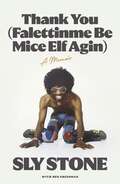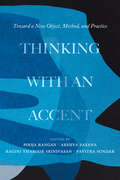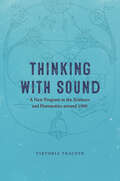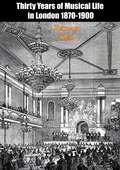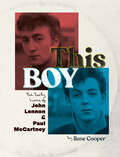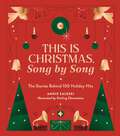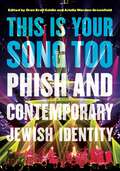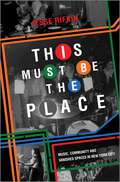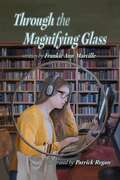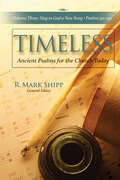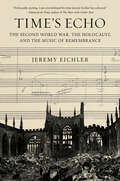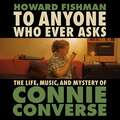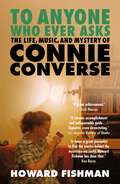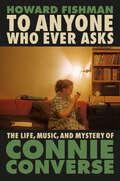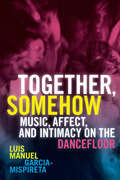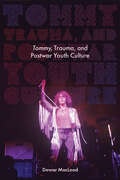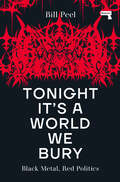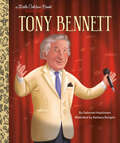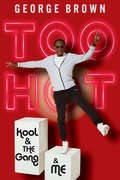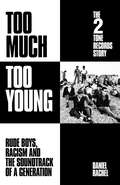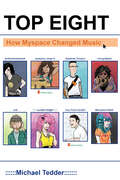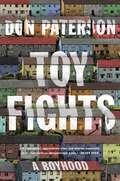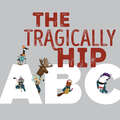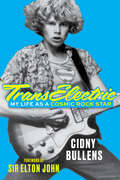- Table View
- List View
Thank You (Falettinme Be Mice Elf Agin)
by Sly StoneOne of the few indisputable geniuses of pop music, Sly Stone is a trailblazer who created a new kind of music, mixing Black and white, male and female, funk and rock; penned some of the most iconic anthems of the 1960s and 70s, from "Everyday People" to "Family Affair"; and electrified audiences with a persona and stage presence that set a lasting standard for pop culture performance. Yet he has also been a cautionary tale, known as much for how he dropped out of sight as for what put him in the spotlight in the first place. As much as people know the music, the man remains a mystery. In Thank You, his much-anticipated memoir, he's finally ready to share his story - a story that many thought he'd never have the chance to tell. Written with Ben Greenman, who has written memoirs with George Clinton and Brian Wilson among others, Thank You will include a foreword by Questlove. The book was created in collaboration with Sly Stone's manager Arlene Hirschkowitz. "For as long as I can remember folks have been asking me to tell my story," says Stone. "I wasn't ready. I had to be in a new frame of mind to become Sylvester Stewart again to tell the true story of Sly Stone. It's been a wild ride and hopefully my fans enjoy it too."
Thinking with an Accent: Toward a New Object, Method, and Practice (California Studies in Music, Sound, and Media #3)
by Pooja Rangan, Akshya Saxena, Ragini Tharoor Srinivasan, and Pavitra SundarA free ebook version of this title is available through Luminos, University of California Press’s Open Access publishing program. Visit www.luminosoa.org to learn more. Everyone speaks with an accent, but what is an accent? Thinking with an Accent introduces accent as a powerfully coded yet underexplored mode of perception that includes looking, listening, acting, reading, and thinking. This volume convenes scholars of media, literature, education, law, language, and sound to theorize accent as an object of inquiry, an interdisciplinary method, and an embodied practice. Accent does more than just denote identity: from algorithmic bias and corporate pedagogy to migratory poetics and the politics of comparison, accent mediates global economies of discrimination and desire. Accents happen between bodies and media. They negotiate power and invite attunement. These essays invite the reader to think with an accent—to practice a dialogical and multimodal inquiry that can yield transformative modalities of knowledge, action, and care.
Thinking with Sound: A New Program in the Sciences and Humanities around 1900
by Viktoria TkaczykThinking with Sound traces the formation of auditory knowledge in the sciences and humanities in the decades around 1900. When the outside world is silent, all sorts of sounds often come to mind: inner voices, snippets of past conversations, imaginary debates, beloved and unloved melodies. What should we make of such sonic companions? Thinking with Sound investigates a period when these and other newly perceived aural phenomena prompted a far-reaching debate. Through case studies from Paris, Vienna, and Berlin, Viktoria Tkaczyk shows that the identification of the auditory cortex in late nineteenth-century neuroanatomy affected numerous academic disciplines across the sciences and humanities. “Thinking with sound” allowed scholars and scientists to bridge the gaps between theoretical and practical knowledge, and between academia and the social, aesthetic, and industrial domains. As new recording technologies prompted new scientific questions, new auditory knowledge found application in industry and the broad aesthetic realm. Through these conjunctions, Thinking with Sound offers a deeper understanding of today’s second “acoustic turn” in science and scholarship.
Thinking with Sound: A New Program in the Sciences and Humanities around 1900
by Viktoria TkaczykThinking with Sound traces the formation of auditory knowledge in the sciences and humanities in the decades around 1900. When the outside world is silent, all sorts of sounds often come to mind: inner voices, snippets of past conversations, imaginary debates, beloved and unloved melodies. What should we make of such sonic companions? Thinking with Sound investigates a period when these and other newly perceived aural phenomena prompted a far-reaching debate. Through case studies from Paris, Vienna, and Berlin, Viktoria Tkaczyk shows that the identification of the auditory cortex in late nineteenth-century neuroanatomy affected numerous academic disciplines across the sciences and humanities. “Thinking with sound” allowed scholars and scientists to bridge the gaps between theoretical and practical knowledge, and between academia and the social, aesthetic, and industrial domains. As new recording technologies prompted new scientific questions, new auditory knowledge found application in industry and the broad aesthetic realm. Through these conjunctions, Thinking with Sound offers a deeper understanding of today’s second “acoustic turn” in science and scholarship.
Thirty Years of Musical Life in London 1870-1900
by Hermann KleinFantastic autobiography of esteemed English musician Herman Klein who earned worldwide fame as an author, journalist, critic and vocal teacher.Herman Klein (born Hermann Klein; 23 July 1856 – 10 March 1934) was an English music critic, author and teacher of singing. Klein's famous brothers included Charles and Manuel Klein. His second wife was the writer Kathleen Clarice Louise Cornwell, and one of their children was the writer Denise Robins.For thirteen years, Klein was a vocal teacher at the Guildhall School of Music in London, becoming a lifelong proponent of the methods of Manuel Garcia and helping to edit Garcia's book on the subject. In 1876 he took up musical journalism, writing for The Sunday Times from 1881–1901, among other publications. He also contributed prolifically to The Musical Times. From 1901 to 1909, Klein lived and taught singing in New York City, where he wrote for The New York Herald. He was one of the first critics to take notice of the gramophone and was appointed "musical adviser" to Columbia Records in 1906 in New York. He returned to England in 1909.Klein wrote over half a dozen books about music and singers, as well as English translations of operas and art songs. He was a noted authority on Gilbert and Sullivan. In 1924 he began writing for The Gramophone and was in charge of operatic reviews, as well as contributing a monthly article on singing, from then until his death.
This Boy: The Early Lives of John Lennon & Paul McCartney
by Ilene CooperAn inside look at the early lives of John Lennon and Paul McCartney, This Boy is a perfect book for any young reader embracing their inner Beatlemania.Meant for younger readers, This Boy is a gripping biography of two musical legends. Beginning with their births during World War II England and ending with their famous performance on The Ed Sullivan Show, this book is action packed from beginning to end. Whether you are a lifelong Beatles fan or new to their music, this book is an excellent source of Beatles lore that is relatively unknown. With expert research from Ilene Cooper and rarely seen photographs of the Beatles in their early days, this book will serve as not only an interesting biography of two significant historical figures, but also a fun read about rock and roll and how the lives of two people can change the world.*&“Generously illustrated with period photographs, the beautifully written result is fascinating and compulsively readable, as Cooper dramatically demonstrates that, together, [John Lennon and Paul McCartney] made magic.&”—Booklist, starred review
This Is Christmas, Song by Song: The Stories Behind 100 Holiday Hits
by Annie ZaleskiCelebrate the merriest season of the year with award-winning author and music journalist Annie Zaleski's collection of the 100 most popular and beloved holiday songs of all time. 'Tis the season! Break out the eggnog, hang the mistletoe, blast those Christmas songs, and settle down in your favorite armchair with this beautifully illustrated volume exploring well-known and lesser-known behind-the-scenes stories of the 100 most cherished holiday songs of all time and their everlasting impact. From artists such as Bing Crosby and Ella Fitzgerald all the way up to Mariah Carey and Ariana Grande, this all-encompassing collection of holiday favorites (called one of "the 25 best Christmas books of all time" by Book Riot) is sure to warm your heart during the merriest season of the year. What song was listed in the Guinness Book of World Records as the best-selling single of all time? Which popular Christmas tune was reportedly written to commemorate Thanksgiving? What holiday song led to a special meet-and-greet between the song's 10-year-old singer and a 700-pound hippopotamus? Spanning musical genres and decades of classics and modern hits, some of the featured songs include: &“White Christmas&” by Bing Crosby "All I Want for Christmas Is You" by Mariah Carey "Deck the Halls" by Mannheim Steamroller &“Christmas Tree Farm&” by Taylor Swift &“Christmas Time (Is Here Again)" by The Beatles &“Feliz Navidad&” by José Feliciano "Rudolph the Red-Nosed Reindeer" by Gene Autry "You Make It Feel Like Christmas" by Gwen Stefani &“Santa Baby&” by Eartha Kitt &“Rockin&’ around the Christmas Tree&” by Brenda Lee &“Merry Christmas, Happy Holidays&” by NSYNC &“Run Rudolph Run&” by Chuck Berry And many more! Including full-color illustrations throughout, this gorgeously packaged compendium is the perfect gift for you and your loved ones to experience the holiday magic year after year.
This Is Your Song Too: Phish and Contemporary Jewish Identity (Dimyonot)
by Oren Kroll-Zeldin and Ariella Werden-GreenfieldPhish has a diehard fan base and a dedicated community of enthusiasts—called Phishheads—who follow the band around the country, some fans attending every show. What may be surprising is that a significant percentage of Phishheads are Jewish.Two members of the band—bassist Mike Gordon and drummer Jonathan Fishman—were raised in Jewish households, and Phish has been known to play Hebrew songs in concert. At live shows, many attendees, some wearing T-shirts emblazoned with “Phish” written in Hebrew letters, express feeling something special—even distinctly Jewish—during their performances. As this book shows, Phish is one avenue through which many Jews find cultural and spiritual fulfillment outside the confines of traditional and institutional Jewish life. In effect, Phish fandom and the live Phish experience act as a microcosm through which we see American Jewish religious and cultural life manifest in unique and unexpected spaces.Featuring an interview with Mike Gordon and a collection of fascinating photographs, This Is Your Song Too is an in-depth look at Jewishness in the Phish universe that also provides a deeper understanding of how spirituality, ritual, and identity function in the world of rock and roll.In addition to the editors, the contributors include Evan S. Benn, Dean Budnick, Jacob A. Cohen, Benjamin David, Jessy Dressin, Josh Fleet, Mike Greenhaus, Joshua S. Ladon, Noah Munro Lehrman, Caroline Rothstein, and Isaac Kandall Slone.
This Must Be the Place: Music, Community and Vanished Spaces in New York City
by Jesse RifkinA fascinating history that examines how real estate, gentrification, community and the highs and lows of New York City itself shaped the city&’s music scenes from folk to house music. Take a walk through almost any neighborhood in Manhattan and you&’ll likely pass some of the most significant clubs in American music history. But you won&’t know it—almost all of these venues have been demolished or repurposed, leaving no record of what they were, how they shaped music scenes or their impact on the neighborhoods around them. Traditional music history tells us that famous scenes are created by brilliant, singular artists. But dig deeper and you&’ll find that they&’re actually created by cheap rent, empty space and other unglamorous factors that allow artistic communities to flourish. The 1960s folk scene would have never existed without access to Greenwich Village&’s Washington Square Park. If the city hadn&’t gone bankrupt in 1975, there would have been no punk rock. Brooklyn indie rock of the 2000s was only able to come together because of the borough&’s many empty warehouse spaces. But these scenes are more than just moments of artistic genius—they&’re also part of the urban gentrification cycle, one that often displaces other communities and, eventually, the musicians themselves. Drawing from over a hundred exclusive interviews with a wide range of musicians, deejays and scenesters (including members of Peter, Paul and Mary; White Zombie; Moldy Peaches; Sonic Youth; Treacherous Three; Cro-Mags; Sun Ra Arkestra; and Suicide), writer, historian and tour guide Jesse Rifkin painstakingly reconstructs the physical history of numerous classic New York music scenes. This Must Be the Place examines how these scenes came together and fell apart—and shows how these communal artistic experiences are not just for rarefied geniuses but available to us all.
Through the Magnifying Glass
by Frankie Ann Marcille Patrick ReganJulia is just your average middle schooler. She loves spending time with her family and friends, reading, and listening to music or podcasts. She especially loves listening to old-school Sherlock Holmes radio shows on YouTube. But Julia doesn't feel like everyone else. Having a vision impairment sometimes makes her feel like she doesn't fit in anywhere. She's not totally blind, but she's not sighted either. Her family and teachers for the blind encourage her to use adaptive devices, like a white cane, or assistive technology, like a screen reader, to help her, but Julia has no interest. She wants to be just like everyone else, specifically her older brother, John, the town hero, most popular guy in high school, mystery-solving, John.
Timeless--Ancient Psalms for the Church Today, Volume Three: Sing to God a New Song, Psalms 90-150 (Timeless--Ancient Psalms for the Church Today #3)
by Mark R. ShippA Psalter/Commentary combining in-depth study of Psalms 90–150 with 140 new songs. This volume, encompassing Psalms 90–150, is the final volume of the series. Volume one covered Psalms 1–41, and volume two incorporated Psalms 42–89. The intent of this series is not to produce technical volumes; rather, they are intended for use by church leaders, ministers, informed lay persons, and Bible teachers to obtain basic understanding of some of the concerns and issues found in a particular psalm, and go from there to an application of the psalm for present-day worship in song. For each psalm there is a translation, treatment of its structure and theology, and then two or more musical settings. This variety demonstrates several ways of bringing the Psalms into Christian worship. Most of the music in Timeless is intended for congregational singing. Timeless is an ecumenical and international project. While having its origin in the a cappella tradition of Churches of Christ, the book is based on the conviction that all Christian communions share the original hymnbook of the second temple and the church. The editor, therefore, has solicited commentaries, compositions, and lyrics from a broad range of Christian traditions.
Time's Echo: The Second World War, the Holocaust, and the Music of Remembrance
by Jeremy EichlerA stirring account of how music bears witness to history and carries forward the memory of the wartime pastIn 1785, when the great German poet Friedrich Schiller penned his immortal &“Ode to Joy,&” he crystallized the deepest hopes and dreams of the European Enlightenment for a new era of peace and freedom, a time when millions would be embraced as equals. Beethoven&’s Ninth Symphony then gave wing to Schiller&’s words, but barely a century later these same words were claimed by Nazi propagandists and twisted by a barbarism so complete that it ruptured, as one philosopher put it, &“the deep layer of solidarity among all who wear a human face.&”When it comes to how societies remember these increasingly distant dreams and catastrophes, we often think of history books, archives, documentaries, or memorials carved from stone. But in Time&’s Echo, the award-winning critic and cultural historian Jeremy Eichler makes a passionate and revelatory case for the power of music as culture&’s memory, an art form uniquely capable of carrying forward meaning from the past.With a critic&’s ear, a scholar&’s erudition, and a novelist&’s eye for detail, Eichler shows how four towering composers—Richard Strauss, Arnold Schoenberg, Dmitri Shostakovich, and Benjamin Britten—lived through the era of the Second World War and the Holocaust and later transformed their experiences into deeply moving, transcendent works of music, scores that echo lost time. Summoning the supporting testimony of writers, poets, philosophers, musicians, and everyday citizens, Eichler reveals how the essence of an entire epoch has been inscribed in these sounds and stories. Along the way, he visits key locations central to the music&’s creation, from the ruins of Coventry Cathedral to the site of the Babi Yar ravine in Kyiv. As the living memory of the Second World War fades, Time&’s Echo proposes new ways of listening to history, and learning to hear between its notes the resonances of what another era has written, heard, dreamed, hoped, and mourned. A lyrical narrative full of insight and compassion, this book deepens how we think about the legacies of war, the presence of the past, and the renewed promise of art for our lives today.
To Anyone Who Ever Asks: The Life, Music, and Mystery of Connie Converse
by Howard FishmanA biography of the mythic singer songwriter Connie Converse, who mysteriously disappeared after recording her debut album and was never seen again.When musician and New Yorker contributor Howard Fishman first heard Connie Converse's voice, he was convinced she could not be real. Her recordings were too out of place for the 1950s to make sense - a singer who bridged the gap between traditional Americana and the singer-songwriter movement that exploded a decade later with Bob Dylan and Joni Mitchell.Howard was determined to know more about this artist and how she slipped through the cracks of music history but there was one problem: in 1974, at the age of fifty, Connie simply drove off one day and was never heard from again.After a dozen years of research, Fishman expertly weaves a narrative of her life and music, and of how it has come to speak to him as both an artist and a person. He discovers fans who Connie's music touched deeply and still remember the lyrics to songs they'd heard only once or twice over 50 years ago.It is by turns a hopeful, inspiring, melancholy, and chilling story of dark family secrets, taciturn New England traditions, a portrait of 1950s Greenwich Village, and of a woman who fiercely strove for independence when the odds were against her. Ultimately, Fishman shows that Connie was a significant outsider artist, a missing link pre-empting the reflective, complex, arresting music that transformed the 1960s and music forever.(P) 2023 Penguin Audio
To Anyone Who Ever Asks: The Life, Music, and Mystery of Connie Converse
by Howard FishmanThe mysterious true story of Connie Converse - a mid-century New York singer and songwriter whose haunting music never gained widespread recognition - and one writer's quest to understand her life.When musician and New Yorker contributor Howard Fishman first heard a Connie Converse recording, he was convinced she could not be real. Her music was too out of place for the 1950s to make sense - a singer who bridged the gap between traditional Americana, pop standards, and the singer-songwriter movement that exploded a decade later with Bob Dylan and Joni Mitchell.Fishman was determined to know more about this artist and how she slipped through the cracks of music history but there was one problem: in 1974, at the age of fifty, Converse simply drove off one day and was never heard from again.After a dozen years of research, Fishman expertly weaves a narrative of her life and music, and of how it has come to speak to him as both an artist and a person.It is by turns a hopeful, inspiring, melancholy, and chilling story of dark family secrets, taciturn New England traditions, a portrait of 1950s Greenwich Village, of a visionary intellect and talent, and a woman who fiercely strove for independence when the odds were against her. Ultimately, Fishman places Converse in the canon as a vital, overlooked trailblazer, a missing link pre-empting the reflective, complex, arresting music that transformed the 1960s and music forever.
To Anyone Who Ever Asks: The Life, Music, and Mystery of Connie Converse
by Howard FishmanThe mysterious true story of Connie Converse—a mid-century New York City songwriter, singer, and composer whose haunting music never found broad recognition—and one writer&’s quest to understand her lifeThis is the mesmerizing story of an enigmatic life. When musician and New Yorker contributor Howard Fishman first heard Connie Converse&’s voice on a recording, he was convinced she could not be real. Her recordings were too good not to know, and too out of place for the 1950s to make sense—a singer who seemed to bridge the gap between traditional Americana (country, blues, folk, jazz, and gospel), the Great American Songbook, and the singer-songwriter movement that exploded a decade later with Bob Dylan and Joni Mitchell. And then there was the bizarre legend about Connie Converse that had become the prevailing narrative of her life: that in 1974, at the age of fifty, she simply drove off one day and was never heard from again. Could this have been true? Who was Connie Converse, really? Supported by a dozen years of research, travel to everywhere she lived, and hundreds of extensive interviews, Fishman approaches Converse&’s story as both a fan and a journalist, and expertly weaves a narrative of her life and music, and of how it has come to speak to him as both an artist and a person. Ultimately, he places her in the canon as a significant outsider artist, a missing link between a now old-fashioned kind of American music and the reflective, complex, arresting music that transformed the 1960s and music forever. But this is also a story of deeply secretive New England traditions, of a woman who fiercely strove for independence and success when the odds were against her; a story that includes suicide, mental illness, statistics, siblings, oil paintings, acoustic guitars, cross-country road trips, 1950s Greenwich Village, an America marching into the Cold War, questions about sexuality, and visionary, forward thinking about race, class, and conflict. It&’s a story and subject that is by turn hopeful, inspiring, melancholy, and chilling.
Together, Somehow: Music, Affect, and Intimacy on the Dancefloor
by Luis Manuel Garcia-MispiretaIn Together, Somehow, Luis Manuel Garcia-Mispireta examines how people find ways to get along and share a dancefloor, a vibe, and a sound. Drawing on time spent in the minimal techno and house music subscenes in Chicago, Paris, and Berlin as the first decade of the new millennium came to a close, Garcia-Mispireta explains this bonding in terms of what he calls stranger-intimacy: the kind of warmth, sharing, and vulnerability between people that happens surprisingly often at popular electronic dance music parties. He shows how affect lubricates the connections between music and the dancers. Intense shared senses of sound and touch help support a feeling of belonging to a larger social world. However, as Garcia-Mispireta points out, this sense of belonging can be vague, fluid, and may hide exclusions and injustices. By showing how sharing a dancefloor involves feeling, touch, sound, sexuality, and subculture, Garcia-Mispireta rethinks intimacy and belonging through dancing crowds and the utopian vision of throbbing dancefloors.
Tommy, Trauma, and Postwar Youth Culture (Excelsior Editions)
by Dewar MacLeodTommy, Trauma, and Postwar Youth Culture traces the development of one of rock music's central masterpieces and its relation to the social-cultural history of the era. Composer and guitarist Pete Townshend was the creative force behind the Who, one of Britain's greatest rock bands. Townshend grew up in an England decimated by the loss of life and hope that was the initial legacy of World War II. The product of a troubled childhood, Townshend faced ongoing struggles with sexual and personal trauma that colored his later work as a performer. An ambitious composer who wanted to create both pop hits and lasting personal works, Townshend achieved his greatest success with the Who through their 1969 rock opera, Tommy. Townshend gave many accounts of the work's evolution and its significance to him and he participated in and encouraged its continued legacy. Dewar MacLeod recounts his own interactions with Townshend and Tommy to draw out the work's impact, its critical reception, its place both in postwar history and the rock era, and its continuing relevance. This book will appeal to all interested in the history of rock, the creative process, and the long shadow of the 1960s.
Tonight It’s a World We Bury: Black Metal, Red Politics
by Bill PeelTonight It&’s a World We Bury explores a range of tendencies central to black metal and uncovers their potential as critiques of capitalism.Tonight It's a World We Bury is a radical re-writing of the history and politics of black metal music.Challenging the commonly-held perception that black metal is a genre of the right — full of wannabe Vikings, Nazis, skinheads and other unsavoury characters — Tonight It's a World We Bury looks at an array of black metal artists to re-affirm the genre as radically anticapitalist, revolutionary and left-wing.Utilizing an eclectic range of black metal bands, including Darkthrone, Burzum, Liturgy and Deathspell Omega, and taking in the works of Marx, Nietzsche, Deleuze and more, Tonight It's a World We Bury is a book on black metal like no other.
Tony Bennett: A Little Golden Book Biography (Little Golden Book)
by Deborah HopkinsonHelp your little one dream big with a Little Golden Book biography about Tony Bennett, the legendary crooner of pop and jazz classics, including "I Left My Heart in San Francisco." Little Golden Book biographies are the perfect introduction to nonfiction for preschoolers!This Little Golden Book about Tony Bennett--beloved and award-winning singer and painter whose voice has touched people&’s hearts--is an inspiring read-aloud for young children, as well as their parents and grandparents who grew up listening to his records.Look for more Little Golden Book biographies: • Willie Nelson • Beyoncé • Dolly Parton • Taylor Swift
Too Hot: Kool & the Gang & Me
by George Brown Dave SmithermanGrowing up around music, young George was inspired to piece together a makeshift drum set and teach himself to play as he practiced in the dark, dank basement of his run-down New Jersey row house. He soon joined forces with his friends to form a group called the Jazziacs which then evolved into Kool & The Gang, a band that began playing clubs and charting hits while its members were still teenagers. By evolving their sound as musical tastes changed, the band was able to stay on the charts for decades, scoring twelve top-ten hits in funk, R&B, pop, and rock, and selling over seventy million albums while navigating the highs and lows of their career. In Too Hot, drummer, keyboardist, and primary songwriter George Brown describes life in and out of the band, including a raucous life on the road as the band's popularity grew. He weathered the ups and downs of his musical career and navigated many challenges including prescription drug addiction, depression, and health issues. George shares how his recent cancer scare, and subsequent treatment, compelled him to share his story, warts and all, to give readers a glimpse into a band whose reputation was considered relatively tame, but in reality, it was exactly the opposite.George hopes to help others realize their own professional and personal dreams—life is a symphony, and we must all be our own conductor.
Too Much Too Young: Rude Boys, Racism and the Soundtrack of a Generation
by Daniel RachelIn 1979, 2 Tone exploded into the national conscience as records by The Specials, The Selecter, Madness, The Beat, and The Bodysnatchers burst onto the charts and a youth movement was born.2 Tone was black and white: a multi-racial force of British and Caribbean island musicians singing about social issues, racism, class and gender struggles. It spoke of injustices in society and took fight against right wing extremism.The music of 2 Tone was exuberant: white youth learning to dance to the infectious rhythm of ska and reggae; and crossed with a punk attitude to create an original hybrid. The idea of 2 Tone was born in Coventry, masterminded by a middle-class art student raised in the church. Jerry Dammers had a vision of an English Motown. Borrowing £700, the label's first record featured 'Gangsters' by The Specials' backed by an instrumental track by the, as yet, unformed, Selecter. Within two months the single was at number six in the national charts. Dammers signed Madness, The Beat and The Bodysnatchers as a glut of successive hits propelled 2 Tone onto Top of the Pops and into the hearts and minds of a generation. However, soon infighting amongst the bands and the pressures of running a label caused 2 Tone to bow to an inevitable weight of expectation and recrimination. Still under the auspices of Jerry Dammers, 2 Tone entered in a new phase. Perhaps not as commercially successful as its 1979-1981 incarnation the label nevertheless continued to thrive for a further four years releasing a string of fresh signings and a stunning end-piece finale in '(Free) Nelson Mandela'. Told in three parts, Too Much Too Young is the definitive story of a label that for a brief, bright burning moment, shaped British culture.
Top Eight: How MySpace Changed Music
by Michael Tedder"A brilliant and addictive chronicle of a pop explosion that helped shape our moment. An absolute delight to read." —Rob Sheffield, bestselling author of Love is a Mix Tape, Dreaming the Beatles, and other books In extensive interviews with scene pioneers and mainstays including Chris Carrabba (Dashboard Confessional), Geoff Rickly (Thursday), Frank Iero (My Chemical Romance), Gabe Saporta (Midtown/Cobra Starship), and Max Bemis (Say Anything), veteran music journalist Michael Tedder has crafted a once-in-a-generation exploration of emo and The Scene that is as forthright as it is tenderly nostalgic, taking to task the elements of toxic masculinity and crass consumerism that bled out of the early 2000s cultural milieu and ultimately led to the implosion of emo's first home and the best social media network, MySpace. When MySpace thrived, the Internet was still fun. Top Eight recalls the excitement and freedom of the era, an unprecedented time when a generation of fans were able to connect directly with the bands and musicians they idolized, from Colbie Caillat to Lil Jon. MySpace changed everything, and Top Eight gives major voices of the era the chance to tell us why it couldn't last.
Toy Fights: A Boyhood
by Don Paterson“It’s wonderful, aggressively wise, and always—especially at its most serious—devastatingly funny.” —Geoff Dyer For readers of Douglas Stuart and Nick Hornby comes an uproarious, tenderhearted memoir of growing up in working-class Dundee in the 1970s and 1980s. Don Paterson is one of our most acclaimed contemporary poets, possessed of “an infinite sensitivity to the world” (Zadie Smith). But his current standing gives few hints of his hilariously misspent youth. An indifferent student prone to obsessions (with girls at school and . . . origami), Paterson nevertheless made clear early on his immense gift for observation. In Toy Fights, he vividly re-creates the customs of the Scottish working class, from the titular childhood game (“basically twenty minutes of extreme violence without pretext”) to the virtues of the sugary sweet known as tablet. When American pop culture arrived, Paterson fell hard for the so-called outlaw sound; by his teens, he was traveling with his father, a Stetson-wearing “country” musician, and becoming guitar-mad himself. A memoir of family, music, and highly inventive profanity, Toy Fights is an unforgettable account of the years we all spend in rehearsal for real life.
The Tragically Hip ABC
by The Tragically HipA love letter to The Tragically Hip, one of Canada's most beloved bands, this ABC picture book features illustrations from four renowned Canadian illustrators.The Tragically Hip, fronted by the late Gord Downie, is a legendary, bestselling Canadian band. And now, almost forty years of music can be appreciated in a brand-new way: an ABC picture book! From "A is for Ahead by a Century" to "N is for New Orleans is Sinking" all the way to "Z is for Frozen in My Tracks," this illustrated ode to the band will be enjoyed by readers of all ages. Featuring art from Canadian illustrators Clayton Hanmer, Julia Breckenreid, Bridget George and Monika Melnychuk, this is the perfect gift for Hip fans old and new!
TransElectric: My Life as a Cosmic Rock Star
by Cidny Bullens Sir Elton JohnFrom the depths of the '70s rock 'n' roll excesses through unimaginable personal losses to an inspiring late-life transformation, Cidny Bullens's story is an utterly compelling journey about living and singing with your authentic voice. An androgynous gender-bending musician from the get-go, Bullens toured extensively with Sir Elton John and performed with Bob Dylan, undergoing a complete immersion in the drug-fueled excesses of 1970s rock 'n' roll. Despite getting sober, climbing the charts with the Grammy-nominated Survivor, as well as a Grammy nomination for his lead vocals in the soundtrack for the movie Grease, Bullens was unable to break out as a solo star in a world that allowed its artists to cross the gender line, but had much more narrow expectations about how women could behave and perform. Retreating into the conventional lifestyle of a suburban mom, Bullens felt like she was living in an alternate universe. Then whatever world she had was shattered by the tragic death of her younger daughter from cancer. Out of the ashes of despair, Bullens brought forth an award-winning album, Somewhere Between Heaven and Earth, that relaunched the musician's career. Finally, nine years ago, Cidny claimed his own healing and transitioned from female to male—finding unexpected love, becoming a new stepfather and a grandfather.What he found, too, was his true voice and true power as a performer.
